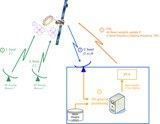
-
StatusCompleted
-
Status date2015-08-31
-
Activity Code5B.076
The objective of the project is, building on the Inmarsat 4 experience, to improve the system performance in order to meet more stringent pointing requirements of large deployable reflectors (12 m), in particular by introducing electronic beam steering compensation. The first application of this enhanced pointing system will be on Alphasat.
Major system design aspects to be investigated are:
- Enhancement of the attitude determination algorithm to improve resilience to noise,
- Enhancement of the control loop robustness to transient events (increasing the bandwidth) and achieve better pointing performance,
- Specification of the measurement devices,
- Specification of beacon locations and separation to improve the measurement accuracy.
The enhanced system is directly adapted to geomobile L/S-band payloads. The market for mobile GEO commercial services has been quite active for many years and is expected to remain robust in the coming years with large operators like Inmarsat.
The main benefits of the antenna pointing optimisation system are the following :
- mass savings, and satellite recurring cost savings (no specific units on board)
- pointing performance target : ≤ 0.05°
- de-coupling of antennas pointing performances from satellite attitude control
- building block approach
The RF Sensing method consists in a combination of RF measurements via the RF sensing system, and error corrections by electronic steering (via an update of the payload beam weights resulting in an electronic re-pointing of each beam).
RF measurements are performed through quartets of dedicated beams, centred on a number of fixed ground beacons. The pointing errors are derived from on-ground processing of those measurements, and a corrected set of beam weights is regularly computed and uploaded to the satellite to compensate the errors.
The following activities have been performed as part of the project :
- definition and simulation of the major blocks of the system
- definition of specifications for ground system components
The project has been concluded by the in-orbit validation of the system on Alphasat.
All activities have now been successfully completed :
- Design and simulation activities
- Ground system components specification
- Ground Software development
- End to end systems tests with the satellite
- In-Orbit Tests and verification of performances





